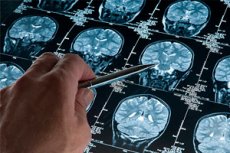
In a recent study published in Nature Medicine, researchers examined the impact of APOE4 (short for apolipoprotein E4) homozygosity on Alzheimer's disease (AD) using pathological, clinical, and biomarker analysis. They found that APOE4 homozygotes exhibit AD pathology and elevated levels of AD biomarkers beginning at age 55, representing a distinct variant of AD and a new target for therapy.
Alzheimer's disease (AD) is associated with both rare and common genetic variants that contribute to its pathogenesis. Mutations in genes such as APP, PSEN1, and PSEN2 cause early-onset autosomal dominant AD (ADAD), while multiple other genes increase the risk of sporadic AD. APOE is a significant genetic risk factor, with APOE4 homozygotes having a significantly higher lifetime risk of AD dementia compared with heterozygotes or noncarriers. However, the predictability of symptom onset in APOE4 homozygotes has not been thoroughly studied. The predictable sequence of pathological, biomarker, and clinical changes in genetically determined asthma provides information about the pathophysiology of asthma. Although previous studies have assessed the influence of APOE on biomarker changes, few have analyzed the effect of gene dosage on asthma biomarker categories in APOE4 homozygotes. Understanding these genetic influences may help in the development of individualized prevention strategies and treatment approaches for asthma.
The aim of this study was therefore to evaluate the pathological, clinical and biomarker changes in individuals with APOE4 homozygosity to determine whether they can be classified as a distinct type of genetically determined dementia, potentially representing one of the most common monogenic diseases.
Two separate sources of human data were used in this study:
- neuropathological study using data from brain donors from the National Alzheimer's Coordinating Center (NACC) (n = 3,297), and
- in vivo analysis from five clinical cohorts with different biomarkers (n = 10,039).
The study included individuals from NACC with neuropathological evaluation, APOE haplotype data, clinical evaluation, and age of onset information. In addition, the five clinical cohorts included data from the Alzheimer's Disease Neuroimaging Initiative, the A4 Study, the ALFA Study, the Wisconsin Alzheimer's Disease Prevention Registry, and the OASIS3 Project. These cohorts covered a variety of biomarkers, focusing on preclinical AD. All available data on clinical diagnosis and APOE haplotype were used for participants.
As part of the biochemical analysis, biofluid measurements were taken from 1,665 participants from three sites. Elecsys technology was used to analyze cerebrospinal fluid (CSF) Aβ1–42 and pTau181 and SIMOA (short for single molecule array) for plasma pTau and NfL. Aβ1–40 measurements were not available at three sites, and the Aβ1–42 or Aβ1–40 ratio was not included.
In brain imaging, hippocampal volume was assessed using T1-weighted MRI (magnetic resonance imaging) in 5,108 participants. In addition, amyloid PET imaging (positron emission tomography) was performed using various tracers in 7,490 participants, and 1,267 participants underwent tau PET imaging with flortaucipir.
In addition, the study used various statistical methods, including chi-square tests, Kruskal-Wallis tests, pairwise comparisons, Kaplan-Meier survival analysis, Cox regression model, and Welch's t-test.
In postmortem data, APOE4 homozygotes consistently showed high or moderate scores for changes in AD neuropathology across all age groups. In vivo biomarker analysis showed that APOE4 homozygotes have significantly higher levels of abnormal biomarkers compared to APOE3 homozygotes, starting at age 55, with almost complete resolution of abnormal biomarker levels by age 65.
APOE4 homozygotes show earlier onset of symptoms of Alzheimer's disease (AD), mild cognitive impairment, dementia, and death compared with APOE3 homozygotes. The predictability of the time to onset of symptoms in homozygotes for APOE4 is comparable to that in individuals with mutations in the PSEN1 gene and Down syndrome.
AD biomarkers in APOE4 homozygotes showed early abnormalities, with changes in cerebrospinal fluid (CSF) Aβ1–42 protein levels and Centiloid scores up to 50 years of age. Increases in phosphorylated tau (pTau) levels in CSF and plasma were observed in the early 50s, approximately 10–15 years before the onset of symptoms. Neurofilament light chain protein levels increased dramatically, indicating neurodegeneration, while hippocampal atrophy began earlier, suggesting a distinct trajectory for APOE4-related biomarkers. Integrated modeling highlighted similarities in biomarker changes between homozygotes for APOE4, ADAD, and Down syndrome, with notable differences in hippocampal atrophy. Changes in biomarkers at the stage of AD dementia did not show significant differences between APOE haplotypes, indicating consistency of pathology regardless of genotype and age. In addition, clear gene dosage effects were found in APOE3 and APOE4 heterozygotes on neuropathology, cognitive changes, age at death, and biomarker profiles.
Despite extensive analysis of APOE4 homozygotes, the study is limited by bias introduced by convenience sample selection, as well as variability between data sets, lack of data on Aβ1–40 levels, cross-sectional design, and predominantly white participant demographics. In the future, it will be a priority to include diverse populations in studies to fully understand the impact of APOE4 on AD risk.
In conclusion, the study provides compelling evidence that APOE4 homozygotes represent a distinct genetic manifestation of Alzheimer's disease. This finding has significant implications for public health, the practice of genetic counseling for carriers, and the direction of future research initiatives.

